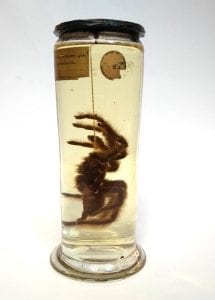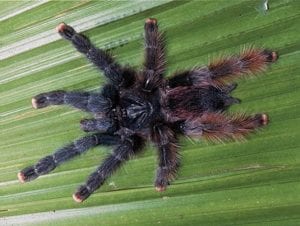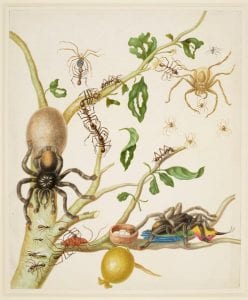Specimen of the Week 360: The Pinktoe Tarantula
By ucwehlc, on 28 September 2018
Specimen of the Week this week is a lovely, fluffy little chap. Despite his fearsome reputation, he means you no harm (unless you are a grasshopper, cockroach or small lizard). With spider season upon us and Halloween around the corner it is the perfect time to convince you he’s not-so-spooky….
**The Pinktoe Tarantula**
Friendly neighbourhood pinktoe
The pinktoe tarantula (Avicularia sp.) is native to South America. It is a sit-and-wait predator which jumps to attack prey or to escape if it is startled. These spiders mostly hunt at night, when they eat large insects and small lizards. Like the majority of spiders, pinktoe tarantulas produce venom, but theirs is mild, and not a danger to humans. They do have another form of defence: the hairs on their abdomens can cause skin irritation. Most tarantulas have these urticating hairs which they can rub off their body to produce a cloud that stings and irritates attackers. Some species of tarantula can produce a nasty reaction in humans, but pinktoe hairs are at worst a mild irritant.
As is common in tarantulas, female pinktoe tarantulas are bigger than males, growing up to 15cm long. Females also live much longer than males, up to 10 years compared to the males’ life span of 3 to 4 years. Our specimen of the week is male, as he has hooks on his forelegs and clubs on his pedipalps, which are the leg-like sensory organs near his mouth. Both of these are adaptations used during mating.
Bird is the word
Avicularia avicularia was one of the first tarantulas described by western scientists, and was named by Linnaeus in 1758. This name has an interesting story behind it. ‘Avicularia’ comes from the Latin for small bird (avicula) or bird-keeper (avicularium). The name Linnaeus chose was influenced by an extraordinary work of art and science published 50 years previously:
Entomologist Maria Sibylla Merian painted this image which includes a pinktoe tarantula eating a hummingbird for her book Metamorphosis Insectorum Surinamensium in 1705. Merian was one of the few early female entomologists and was one of the first European scientists to observe and describe the life cycles of insects, and to study insects in South America. She was also an accomplished artist, and this combination of science, exploration and art made her book a sensation.
It is rare for pinktoe tarantulas to eat birds, and although Merian’s famous picture illustrates a real event that she witnessed in Suriname, it is more likely that the spider is scavenging a dead bird than catching a live one. This was the first depiction of a tarantula to capture the public imagination, and it had an impact on how people saw these spiders. The old label on our specimen reads ‘bird’s nest spider’ or ‘bird eating spider’. ‘Bird spider’ has been used as an English common name for tarantulas and German name for tarantulas Vogelspinnen – literally ‘birdspiders’.
These days the common name bird-eating spider is usually used to refer to the Goliath birdeater (Theraphosa blondi), the heaviest spider in the world. Although they are not its main prey, this species does occasionally eat small birds.
Hannah Cornish is the Curatorial and Collections Assistant at the Grant Museum of Zoology
References
Fukushima CS, Bertani R (2017) Taxonomic revision and cladistic analysis of Avicularia Lamarck, 1818 (Araneae, Theraphosidae, Aviculariinae) with description of three new aviculariine genera. ZooKeys 659: 1-185. https://doi.org/10.3897/zookeys.659.10717
David J. Stradling (1994) Distribution and Behavioral Ecology of an Arboreal `Tarantula’ Spider in Trinidad Biotropica Vol. 26, No. 1 (Mar., 1994), pp. 84-97
And thanks to Danniella Sherwood for additional Avicularia facts
One Response to “Specimen of the Week 360: The Pinktoe Tarantula”
- 1
 Close
Close





I’m extremely pleased to uncover this page. I want
to to thank you for your time for this particularly wonderful read!!
I definitely enjoyed every bit of it and I have you book marked
to see new stuff on your website.